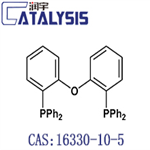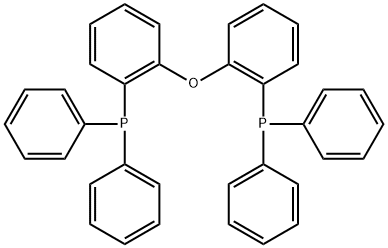Important applications of bis(2-diphenylphosphinophenyl) ether
Sep 6,2022
Introduction
Olmesatrtan medoxomil is an angiotensin II receptor antagonist with good antihypertensive effect. N-triphenylmethyl-5-(4'-bromomethylbiphenyl-2-yl)tetrakis Nitroazole (TBT) is the starting material for the synthesis of olmesartan medoxomil, and there may be impurities without bromine substitution and dibromo substitution, which brings difficulties to the purification of the product[1]. According to the "Technical Guiding Principles for Preparation and Structure Confirmation Research of Chemical Drug Raw Materials", the internal control standards for starting materials that meet the requirements of olmesartan medoxomil synthesis reaction are formulated. The CAS number for bis(2-diphenylphosphonyl) ether is 166330-10-5. The molecular formula of bis(2-diphenylphosphonyl) ether is C36H28OP2. The molecular weight of bis(2-diphenylphosphonyl) ether is 538.55.

Picture 1 Bis(2-diphenylphosphonyl) ether powders
Properties of bis(2-diphenylphosphonyl) ether
Bis(2-diphenylphosphinophenyl) ether are used as chelating ligands in various inorganic reactions, one of which is the preparation of copper(I) dimethylbipyrimidinylphosphinophenyl ether complexes[1]. Bis(2-diphenylphosphonyl) ether is a ligand for the ruthenium-catalyzed green synthesis of amines (amines and alcohols are synthesized by a hydrogen-borrowed reaction). Keep the container tightly sealed and store in a cool, dry place to ensure work There is good ventilation or exhaust in the room. It should be stored separately from oxidants, acids, and edible chemicals, and should not be mixed. Storage areas should be equipped with emergency release equipment and suitable containment materials.
Preparation method of bis(2-diphenylphosphonyl) ether
Bis(2-diphenylphosphonyl) ether can be prepared by one-step reaction of diphenyl ether and diphenylphosphine chloride[1]. (1) Diphenyl ether (0.02 mol) was diluted in hexane (50 mL), at -78°C, a hexane solution of n-BuLi (42 mmol) was added dropwise (the addition was completed in about 5 min), and the reaction was carried out for 1 h, and then The temperature was raised to room temperature (about 25°C), and the reaction was continued to stir for 16 h; (2) 15 mL of n-hexane solution of diphenylphosphine chloride (42 mChemicalbookmol) was then added dropwise to the reaction system of step (1) under an ice-water bath ( The addition was completed in about 5 min), and then the reaction was stirred at room temperature (about 25°C) for 16 h; the solvent was removed by rotary evaporation to obtain a light yellow viscous oil, which was washed with acetone and dried in vacuo to obtain 9.4 g of white powder, which is double (2-diphenylphosphonyl) ether: 87% yield[1].
Application of Bis(2-diphenylphosphonyl) ether
Phosphorescent organic electroluminescent materials are favored by researchers because they can achieve 100% internal quantum efficiency[2]. Among the many heavy metal complexes, Ir(III) metal complexes have the best properties. However, in recent years, the reserves of Ir in nature have become less and less, and the price has become more and more expensive. Looking for Ir(III) metal complexes A replacement is imminent. Due to its large reserves and low price, Cu metal complexes have become the best substitutes for Ir(Ⅲ) metal complexes. The P atom in phosphorus-containing organic ligands has strong electron-donating properties, which can increase the energy level of the d-d excited state of the metal center, thereby preventing non-radiative transitions; at the same time, a strong Cu-P coordination bond is formed, which makes the luminescence The spectrum blue-shifted to obtain blue phosphorescent emissive material. Based on this, this paper uses bis(2-diphenylphosphonium phenyl) ether and triphenylphosphonium as the main ligands, iodine atom, 2-(2-pyridine) phenylimidazole and 2-(5-phenyl- A series of neutral and ionic Cu(Ⅰ) metal complexes have been prepared by using 1,2,3-triazole)pyridine as auxiliary ligand, which are neutral dimer [(POP)CuI]2, ionic of [Cu(PPh3)2(pybi)]BF4, [Cu(PPh3)2(pptZ)]BF4 and [Cu(POP)(pptz)]BF4.
Reference
1 John P. Wolfe, Shiqing Xu, Masato Komiyama, Ei-ichi Negishi. Encyclopedia of Reagents for Organic Synthesis.
2 Zhang, Y.-R., Cui, Y.-Z., Jin, Q.-H., Yang, Y.-P., Liu, M., Li, Z.-F., … Zhang, C.-L. (2017). Syntheses, structural characterizations and terahertz spectra of Ag(I)/Cu(I) complexes with bis[2-(diphenylphosphino)phenyl]ether and N^N ligands. Polyhedron, 122, 86–98.
- Related articles
- Related Qustion
N-(triphenylmethyl)-5-(4'-bromomethylbiphenyl-2-yl)tetrazolium, is a chemical substance with the molecular formula C33H25BrN4, which is used as an intermediate for the drug irbesartan.....
Sep 6,2022APIAtibuclimab (IC14) is a chimeric CD14 antibody investigated for the treatment of patients with severe sepsis. It is Investigated for use/treatment in sepsis and septicemia and pneumonia.....
Sep 6,2022API(OXYDI-2,1-PHENYLENE)BIS(DIPHENYLPHOSPHINE)
166330-10-5You may like
(OXYDI-2,1-PHENYLENE)BIS(DIPHENYLPHOSPHINE) manufacturers
- Bis(2-diphenylphosphinophenyl)ether
-

- $1.00 / 1KG
- 2025-12-12
- CAS:166330-10-5
- Min. Order: 1KG
- Purity: 99%
- Supply Ability: 20 Tons
- (OXYDI-2,1-PHENYLENE)BIS(DIPHENYLPHOSPHINE)
-

- $10.00 / 1KG
- 2025-12-11
- CAS:166330-10-5
- Min. Order: 1KG
- Purity: 99%
- Supply Ability: 10 mt
- (OXYDI-2,1-PHENYLENE)BIS(DIPHENYLPHOSPHINE)
-

- $0.00 / 5kg
- 2025-08-02
- CAS:166330-10-5
- Min. Order: 1kg
- Purity: 99.5%
- Supply Ability: 2T





